Canon B115, FAX B140, FAX B120 User Manual
FAX-B140/B120/B115
User’s Guide

1 SETTING UP
Unpacking
As you unpack your fax, save the carton and packing material in case you want to move or ship the fax in the future.
Carefully remove all items from the box.
• It is best to have someone hold the box while you lift the fax and its protective packaging out of the carton. Make sure you have the following items:
Main unit |
Multi-purpose tray |
Document tray |
Handset (FAX-B140/B120 only) |
BX-3 Black BJ cartridge |
You should also have the followings:
•Power cord
•Telephone line cord
•B.T. adaptor (U.K. only)
•Documentation
•Warranty*
•One-touch sheet*
If any of these items are damaged or missing, contact your local authorised Canon dealer or the Canon help line immediately.
* These items are only included in some countries.
1
UP SETTING
1-1

2PREPARING TO USE YOUR FAX
Main components of your fax
Handset  (FAX-B140/
(FAX-B140/
B120 only)
|
|
|
01 |
|
|
02 |
|
|
|
|
|
Report |
|
|
|
||
|
|
|
Cleaning |
03 |
||||
|
|
04 |
|
|
Send |
Options |
||
|
|
|
05 |
|
|
|||
|
|
R |
|
|
|
|
||
|
|
|
Space |
06 |
|
|
||
|
|
|
|
Clear |
|
|||
07 |
|
|
|
|
|
|||
Polling |
|
08 |
|
|
|
|
|
|
Ink |
Saver |
|
09 |
|
|
|
||
Receive |
Mode |
Resolution |
Caller |
History |
|
|
||
|
F |
|
|
|
||||
|
|
|
|
|
unction |
|
|
|
7 PQRS
1
4 GHI
8 TUV
0
FAX-B140
|
2 |
3 |
|
ABC |
|
|
5 |
DEF |
J |
6 |
|
|
KL |
|
|
|
MNO |
|
9 |
|
|
WXYZ |
|
|
# |
|
Document tray
 Multi-purpose tray
Multi-purpose tray
Document guide
Operation panel
 Printer cover
Printer cover
 Cartridge holder
Cartridge holder
Document release button
Please note that your fax may differ from the illustration above.
Note
2
FAX YOUR USE TO PREPARING
2-1
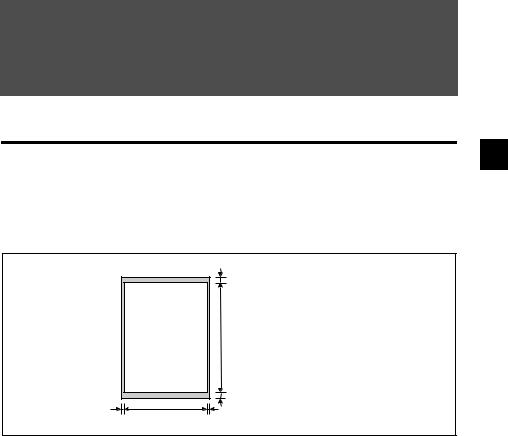
3 DOCUMENTS AND PAPER
Types of documents you can scan
K Size
The fax can scan standard A4-, letter-, or legal-size documents.
K Scanned area
The actual area scanned by the fax is shown below.
3.0w3.0 mm
A4 |
292 |
2.0w2.0 mm
1.0w3.5 mm 208 mm 1.0w3.5 mm
The margin on either side of the sheet and the margin on the top and bottom are not picked up by the scanner.
Problem documents_________________________
•To prevent document jams in the document tray, do not attempt to load the following types of document into the fax:
–Wrinkled or creased paper
–Torn paper
–Coated paper or glossy paper
–Thick paper
•Remove all staples, paper clips, etc. before loading the document into the document tray.
•Make sure any glue, ink or correction fluid on the paper is completely dry before loading the document into the document tray.
•Make a photocopy of any document that will not feed into the fax so that you can then load the copy into the document tray.
3
PAPER AND DOCUMENTS
3-1
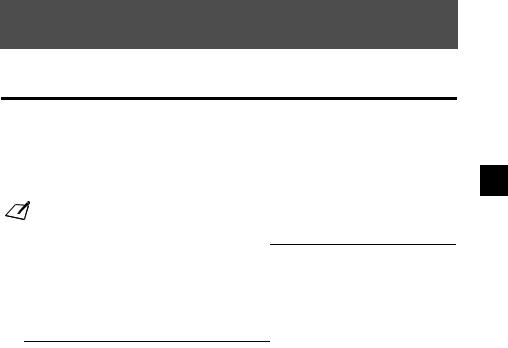
4 MAKING COPIES
Copying documents
One of the convenient features of the fax is its ability to make high quality copies. You can make up to 99 copies of one document at a time.
If you make copies of multiple documents at a time, the number of pages the fax can scan into memory varies depending on the scanning resolutions (see p. 5-1) as follows:
• STANDARD/FINE |
= 25 pages |
• PHOTO |
= 1 page |
• STANDARD and FINE result in the same resolution when making copies.
• If MEMORY FULL appears on the LCD when making multiple copies, see Copying problems, p. 9-13.
Note
1Load the document face up into the document tray.
See Loading documents, p. 3-2.
2 |
|
|
|
|
Press [Resolution]. |
|
|
||
COPY PAGE |
01 |
|||
|
You can select STANDARD/FINE or PHOTO. |
|||
|
|
|
||
|
D |
|
|
|
|
Press [Start/Copy]. |
|
|
3Enter the number of copies (up to 99) using the numeric buttons.
To make a correction to the number of copies, press [Clear] and re-enter the number.
D
Press [Start/Copy].
To stop copying anytime, press [Stop]. You may then need to press [Start/Copy] for a few seconds, then the fax will feed out the document. See Jams in the document tray,
p. 9-1.
4
COPIES MAKING
4-1
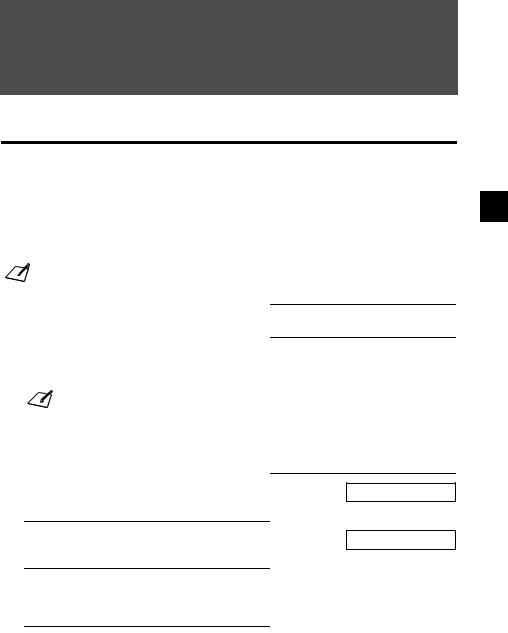
5SENDING DOCUMENTS
Preparing to send a document
Before you send a document, see Chapter 3: DOCUMENTS AND PAPER.
Adjusting the quality of your documents _________
K Setting the scanning resolution
Resolution is a measure of the fineness or clarity of a printout. Low resolutions may cause text and graphics to have a jagged appearance, while higher resolutions provide smoother curves and lines, crisp text and graphics, and a better match to traditional typeface designs.
The higher the resolution, the higher the output quality, but the slower the scanning speed.
Note
1Load the document face up into the document tray.
See Loading documents, p. 3-2.
2Press [Resolution] to select the resolution.
You can select STANDARD, FINE or PHOTO.
After about 5 seconds, the fax returns to standby mode.
You can change the resolution setting while the document is being scanned for sending. However,
please note that your new setting will only be effective from the next page scanned.
Note
K Setting the scanning contrast
Contrast is the difference in brightness between the lightest and darkest parts of a printed document. You can adjust the contrast your fax uses to send or copy documents, according to how light or dark your document is.
1Press [Function].
D |
DATE & TIME |
|
Press [Start/Copy] twice.
2Use [3] or [4] to select SCAN CONTRAST.
D |
STANDARD |
|
Press [Start/Copy].
3Use [3] or [4] to adjust the scanning contrast.
You can select STANDARD, DARKER or LIGHTER.
D
Press [Start/Copy].
4Press [Stop].
Setting ends and the fax returns to standby mode.
5
DOCUMENTS SENDING
5-1
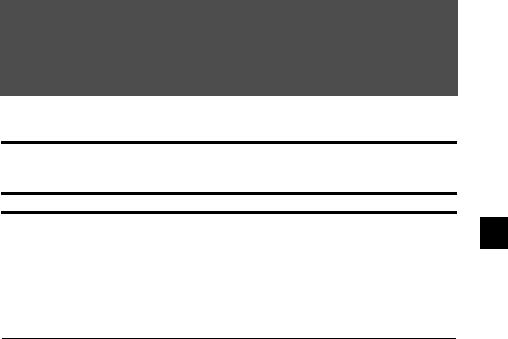
6RECEIVING DOCUMENTS
Different ways to receive a document
Your fax provides you with several modes for receiving documents. To determine which mode best suits your requirements, see the table below.
Receive Mode |
Main Use Operation |
Requirements |
Details |
FAX ONLY MODE |
Fax |
Answers all calls as fax calls. |
|
|
Receives documents |
|
|
automatically and |
|
|
disconnects voice calls. |
Separate telephone |
p. 8-4 |
line for fax use only. If you want to be alerted when a fax call is received, connect the handset, or an extension phone to the fax, and enable the INCOMING RING setting.
FAX/TEL AUTO SW |
Fax/Tel |
Automatically switches |
Handset or extension |
p. 6-2 |
(Fax/Tel mode) |
|
between fax and voice calls. |
phone connected to |
|
|
|
Receives documents |
the fax. |
|
|
|
automatically and rings for |
|
|
|
|
voice calls. |
|
|
|
|
|
|
|
MANUAL MODE |
Tel |
Rings for every call, |
Handset or extension |
p. 6-4 |
|
|
regardless of whether the call |
phone connected to |
|
|
|
is a fax call or a voice call. |
the fax. |
|
|
|
For a fax call, you have to |
|
|
|
|
manually activate reception |
|
|
|
|
of the fax. |
|
|
|
|
|
|
|
ANS.MACHINE |
Fax/Tel |
Receives documents |
Answering machine |
p. 6-4 |
MODE |
|
automatically and routes |
connected to the fax. |
|
(FAX-B120/B115 only) |
|
voice calls to the answering |
|
|
|
|
machine. |
|
|
|
|
|
|
|
NET SWITCH* |
Fax/Tel |
Allows you to have one |
Subscription to the |
|
|
|
telephone line with two |
Telstra FaxStreamTM |
|
|
|
numbers: one for fax and one |
Duet service |
|
|
|
for telephone. |
(Australia) or the |
|
|
|
|
Telecom FaxAbility |
|
|
|
|
service (New |
|
|
|
|
Zealand). |
|
|
|
|
|
|
* This setting is only available for some countries.
6
DOCUMENTS RECEIVING
6-1
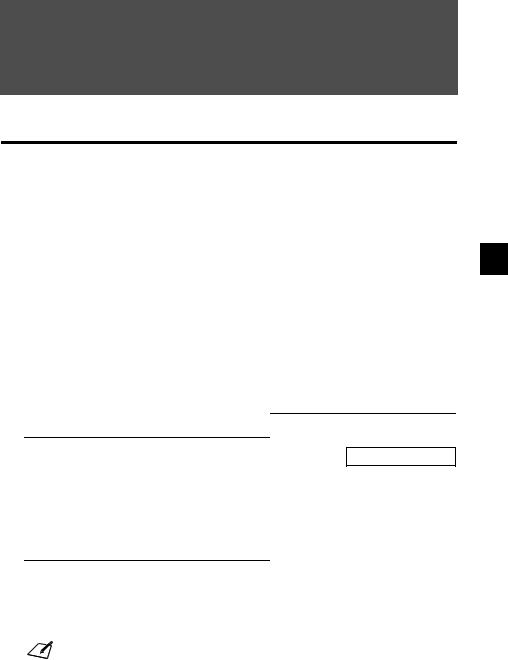
7USING THE BUILT-IN ANSWERING MACHINE (TAM MODE) (FAX-B140 only)
Recording the outgoing message
Before you use TAM MODE, you must record an outgoing message. Use the microphone on the operation panel to record your outgoing message. Only one outgoing message, no longer than 20 seconds, can be recorded.
Types of messages that can be recorded ________
OUTGOING MESSAGE: Answering machine message
ALT OUTGOING MSG: Answering message only, used when the recording time is set to 0 or the
|
memory is full. Caller cannot leave a message. |
VOICE MEMO: |
See p. 7-6. |
FAXTEL MESSAGE: |
Message played when the Fax/Tel mode is set. |
FORWARDING MSG: |
Message played when any new telephone messages are forwarded to a |
|
forwarding number. |
Recording the outgoing message ______________
To record another type of message, select the type of message you want to record in step 1, and then follow the procedure below to record it.
1Use [3] or [4] to select OUTGOING MESSAGE.
2Press [Record] and speak into the microphone to
record your outgoing message. |
TIME LEFT |
19 |
|
|
The remaining recording time is displayed on the LCD.
-or-
Press [Start/Copy], use [3] or [4] to select
RECORD and press [Start/Copy] again. Then speak into the microphone to record your outgoing message.
3Press [Stop] twice when recording is finished.
You can record an alternative outgoing message, fax/ telephone switching message or forwarding message by selecting the appropriate option in step 1 above and then continuing on to steps 2 and 3.
You cannot delete the OUTGOING MESSAGE. To record a new outgoing message, repeat steps 1
to 3 above. The old outgoing message will be automatically deleted when you record your new Note message.
7
MACHINE ANSWERING IN-BUILT THE USING only) B140-(FAX MODE) (TAM
7-1

8SETTINGS AND ACTIVITY REPORTS
Selecting a menu
The USER SETTINGS, REPORT SETTINGS, TX SETTINGS, RX SETTINGS, PRINTER SETTINGS, SYSTEM SETTINGS, and TAM SETTINGS* menus allow you to customise the way your fax works. Each menu contains settings that control different functions of your fax.
1 |
|
|
Press [Function]. |
|
|
|
D |
USER SETTINGS |
|
|
|
|
Press [Start/Copy]. |
|
2Use [3] and [4] to scroll through the menus and select the menu you want.
You can select the USER SETTINGS, REPORT SETTINGS, TX SETTINGS, RX SETTINGS, PRINTER SETTINGS, SYSTEM SETTINGS or TAM SETTINGS* menu (see pp. 8-2 to 8-6).
3Press [Start/Copy] to access the settings under the menu you selected.
4See the tables on the following pages (see pp. 8-2
to 8-6) for guidelines on selecting and registering |
DATE & TIME |
|
|
settings. |
|
•Use [3] and [4] to scroll through the settings.
•To register a setting or access a sub-setting, press [Start/ Copy].
•To return to a previous level, press [Function].
5Press [Stop].
Setting ends and the fax returns to standby mode.
• If at any stage you want to return to standby mode, press [Stop].
• If you pause for more than 60 seconds while accessing a menu, the fax will automatically return to
Note |
standby mode. |
|
8
REPORTS ACTIVITY AND SETTINGS
* FAX-B140 only.
8-1
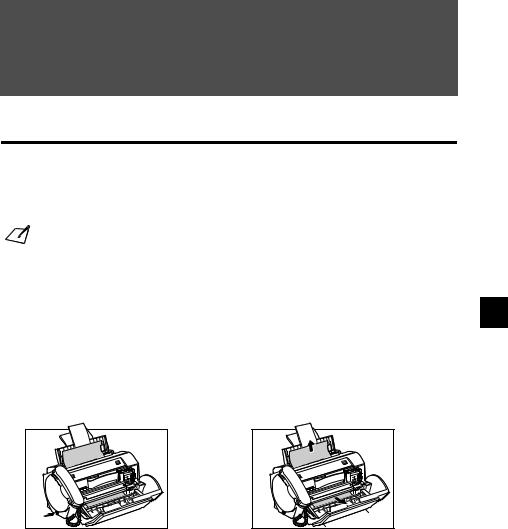
9SOLUTIONS TO COMMON PROBLEMS
Clearing jams
Jams in the document tray ___________________
When a document jams or misfeeds in the document tray, OPEN COVER and SEE FIG. 1 are displayed on the LCD. If the fax does not feed out the document after you press [Start/Copy] for a few seconds, follow the procedures below to remove the document.
You do not need to unplug the fax when clearing document jams.
Note
1Open the printer cover by gently pulling it towards you.
Do not try to pull the document out without opening the printer cover since you may tear or smudge the document.
2 |
Push the document release button on the |
3 |
Remove the document. |
|
left-side panel of the fax. |
|
• Pull it gently in either direction. |
• If you cannot pull the document out easily, hold down [Start/Copy] for a few seconds. The document will be fed out automatically.
• If a multipage document is loaded, remove the entire document from the document tray.
4 |
When you are finished, close the printer |
5 |
Press [Stop]. |
|
cover. |
|
The fax returns to standby mode. |
Be sure to close the printer cover until it locks into place, or the fax will not function properly.
9
PROBLEMS COMMON TO SOLUTIONS
9-1

Specifications
Scanning sheet size: |
Width: |
|
Max. |
216 mm |
Min. |
210 mm |
|
Thickness: |
|
Max. |
0.13 mm |
Min. |
0.06 mm |
Effective scanning size: |
Width: (A4): 208 mm |
|
|
|||
Effective printing size: |
Width: 203 mm |
|
|
|
||
Transmission time: |
G3 ECM MMR: Approx. 6 seconds* |
|
||||
Scanning line density: |
Horizontal: |
|
|
8.00 dots/mm |
|
|
|
Vertical Standard: |
3.85 lines/mm |
|
|||
|
Vertical Fine: |
|
7.70 lines/mm |
|
||
Recording method: |
Bubble Jet printing |
|
|
|
||
Paper tray capacity: |
Maximum: 50 sheets (75 g/m2) |
|
|
|||
Paper type: |
Plain cut sheet paper (A4/Letter/Legal) |
|
||||
|
Paper weight: |
|
64 g/m2 to 90 g/m2 |
|
||
|
Paper thickness: |
0.08 mm to 0.13 mm |
|
|||
Image memory: |
Up to 21 A4-size pages* (standard resolution) |
|||||
Auto dial functions: |
One-touch speed dialling (Registration for 9 numbers) |
|||||
|
Coded speed dialling (Registration for 50 numbers) |
|||||
Ink cartridge: |
Canon BX-3 Black BJ cartridge |
|
|
|||
Power source: |
200-240 V/50-60 Hz |
|
|
|||
Power consumption: |
Standby: |
Approx. 4.5 W |
|
|
||
|
Operation: Approx. 8 W, maximum 34 W |
|||||
Operating environment: |
Temperature: |
10°C to 32.5°C |
|
|
||
|
Humidity: |
|
20% to 85% RH |
|
|
|
Dimensions: 410 mm (W) × 307 mm (D) × 308 mm (H) (including trays)
Weight: Approx. 4.7 kg (with handset)
Specifications are subject to change without notice.
* Based on the Canon FAX Standard Chart No.1, Standard mode.
S-1

t (extension phone) jack 1-5 h (handset) jack 1-4
L (telephone line) jack 1-4
A
AC power cord, connecting 1-6 Access type, registering 1-13 ACTIVITY REPORT
description 8-8 printing 8-7 setting 8-3
Adaptor, B.T. 1-1
ALARM VOLUME setting 8-2 ALT OUTGOING MSG
(Alternative outgoing message)
description 7-1
ANS.MACHINE MODE description 6-1, 6-4 setting 6-4
Answering machine 1-4 connecting 1-4
using fax with 6-4
Attaching components 1-3 AUTO PRINT setting 8-3 AUTO REDIAL
for FWD SETTINGS 8-6 message 9-15
setting 5-9, 8-3
Automatic dialling 5-5
Automatic redialling cancelling 5-9 description 5-9
setting options for 5-10
AUTO TEST PRINT 8-5
B
B.T. adaptor 1-1, 1-5 BJ cartridge
BX-3 Black 1-1, 1-9 cleaning 9-5 guidelines 1-9 installing 1-9, 1-10
print head (See Print head) replacing 9-6
Broadcasting, sequential 5-13 BUSY/NO SIGNAL message 9-15
Index
Buttons 2-2, 2-3 (See also individual button names)
cursor 2-3, 2-5 FAX-B140 2-3 FAX-B120 2-3 FAX-B115 2-3 numeric 2-2, 2-4
one-touch speed dialling 2-2 Rewind/Forward 2-2, 7-8 scroll 2-3, 8-1
special function 2-2
BX-3 Black BJ cartridge 1-1, 1-9
C
Caller history 5-8
CALLING VOLUME setting 8-2 Cancelling
automatic redialling 5-9 delayed sending 5-11 manual redialling 5-9 receiving 6-6
sending 5-5
Cartridge (See BJ cartridge)
Cartridge holder 2-1 CARTRIDGE JAMMED
message 9-15 CHANGE CARTRIDGE message 9-16
CHECK DOCUMENT message 9-16
CHECK PAPER SIZE message 9-16
CHECK PRINTER message 9-16 Cleaning
BJ cartridge print head 9-5 button 2-2, 9-5, 9-6 exterior of fax 9-3
interior of fax 9-3, 9-4 periodic 9-3
print head 9-6
scanner components 9-4
Clear button 2-2, 2-5
CLEAR PAPER JAM message 9-17
Coded dial/Directory button 2-3, 5-5, 5-6
Coded speed dialling description 2-12
list (See Coded speed dialling list)
registering numbers and names for 2-12
sending a document using 5-5
Coded speed dialling list description 8-8 printing 8-7
Components attaching 1-3 main 2-1
Connecting
AC power cord 1-6 answering machine 1-4 extension phone 1-6 external devices 1-4 handset 1-4
telephone 1-5 telephone line 1-4
Connector, power cord 1-6 Contrast, setting scanning 5-1 Copying
documents 4-1 problems 9-13
setting scanning contrast 5-1
Cord, power 1-6 Correcting mistakes 2-5 Cursor buttons 2-3, 2-5 Customer support v
D
DATE & TIME setting 2-6, 8-2 Date, setting 2-6
DATE SETUP setting 8-5 Delayed Sending 5-10
cancelling 5-11
sending other documents while fax is set for 5-11
Delete button 2-3, 7-7 Deleting
document from memory 5-15 message 7-7
Dialling automatic 5-5 directory 5-6
long-distance 5-8 methods 5-2 regular 5-2 special 5-8
through a switchboard 1-12 using caller history 5-8
I-1

Directory dialling, sending a document using 5-6
DISPLAY LANGUAGE setting 8-5
DOC. MEMORY LIST description 8-8 printing 8-7
DOC. TOO LONG message 9-17 Documentation 1-1
Documents
Copying 4-1
deleting from memory 5-15 different ways to receive 6-1 guides 2-1
loading 3-2
polling to receive 6-5 printing document in memory
5-14
printing list of documents in memory 5-14
problem 3-1
problems with multipage 3-2 receiving in memory when a
problem occurs 6-5 receiving manually 6-4 receiving while performing other
tasks 6-5
receiving with an answering machine 6-4
requirements for scanning 3-1 scanned area 3-1
sending 5-2
sending to more than one location 5-13
size 3-1 tray 1-1, 2-1 type 3-1
E
ECM RX message 9-17 setting 8-4
ECM TX message 9-17 setting 8-3
Extension phone 1-4 connecting 1-5
External devices, connecting 1-4
Index
F
Fax
assembling 1-3 cleaning 9-3
main components 2-1 main unit 1-1
making connections 1-4 name, registering 2-7 number, registering 2-7 operation panel 2-2 testing 1-11
unpacking 1-1 weight S-1
FAX-B140 1-1, 2-2, 2-3
FAX-B120 1-1, 2-2, 2-3 FAX-B115 2-2, 2-3 FAX ONLY MODE
description 6-1
FAX/TEL AUTO SW (Fax/Tel mode)
description 6-1 setting 6-2
Fax/Tel mode description 6-1 setting 6-2
Fax/Telephone number, registering 2-7
Faxing problems 9-9 FAXTEL MESSAGE
deleting 7-7 description 7-1
Forwarded call, when a call is received 7-15
FORWARDING MSG deleting 7-7 description 7-1
Forwarding number, setting 7-12 Forwarding telephone messages
7-12
Function button 2-2 FWD SETTINGS 8-6
FWD TEL NUMBER setting 8-6
G
General problems 9-14 Guide
document 2-1
H
Handling and maintenance, safety instructions vi
Handset 1-1, 2-1 connecting 1-4
Hook button 2-3, 5-4
I
INCOMING RING setting 8-4 Ink Saver button 2-2, 6-5 Installing, BJ cartridge 1-9
J
Jack
t (extension phone) 1-5 h (handset) 1-4
L (telephone line) 1-4
Jams
clearing 9-1
in document tray 9-1
in multi-purpose tray 9-2
K
KEYPAD VOLUME setting 8-2
L
LCD 2-2
messages 9-15 to 9-18 (See also individual message names)
Letters, entering 2-4
LINE MONITOR VOL setting 8-2
Line, telephone 1-4, 1-12 List (See individual list names)
Loading documents 3-2 paper 1-7, 1-8
Location, safety instructions vii Long-distance dialling 5-8 Lowercase letter mode 2-4
M
Main unit 1-1
MAN/AUTO SWITCH setting 8-4
I-2

MANUAL MODE description 6-1 receiving in 6-4 setting 6-4
Manual redialling 5-9 cancelling 5-9
Manual sending 5-4 cancelling 5-5
Memory
deleting document from 5-15 documents in 5-14
printing document in 5-14 printing list of documents in
5-14
receiving when problem occurs 6-5
sending (See Memory sending)
MEMORY CLEAR REPORT description 9-19
MEMORY FULL message 9-17, 9-18
MEMORY RX setting 8-4 Memory sending 5-3
cancelling 5-4
Menu (See individual menu names)
PRINTER SETTINGS 8-4
REPORT SETTINGS 8-3
RX (Reception) SETTINGS 8-4 SYSTEM SETTINGS 8-5 TAM SETTINGS 8-6
TX (Transmission) SETTINGS 8-3
USER SETTINGS 8-2
MESSAGE LENGTH setting 8-6 Messages
deleting 7-7
forwarding telephone 7-12 LCD 9-15 (See also individual
message names) playing telephone 7-8
recording the outgoing 7-1 setting the recording time for a
7-3
types that can be recorded 7-1
Microphone (FAX-B140 only) 2-2
MID PAUSE SET setting 8-3 Mistakes, correcting 2-5 Modes, switching number and
letter 2-4
MSG DATA LOST message 9-17
Index
Multi-purpose tray 2-1 capacity S-1
jams in 9-2
loading paper in 1-11
MULTI TX/RX (Transaction) REPORT 8-8
N
NO DATA message 9-18 NO OGM message 9-18 Nozzle check pattern
printing 9-5
Number mode 2-4 Numbers, entering 2-4 Numeric buttons 2-2, 2-4
O
OFFHOOK ALARM setting 5-4, 8-2
One-touch speed dialling buttons 2-2 description 2-10
list (See One-touch speed dialling list)
registering numbers and names for 2-10
sending a document using 5-5
One-touch speed dialling list description 8-8
printing 8-7
Operation panel 2-1, 2-2, 2-3 OUTGOING MESSAGE
description 7-1 recording 7-1
Outside line access number, registering 1-13
P
Paper
guide 1-8 guidelines 1-7
limit mark (See Paper limit mark) loading 1-7
loading in multi-purpose tray 1-8 quantity S-1
requirements 3-3 size 3-3
weight S-1
Paper feeding problems 9-8 Paper limit mark 1-7 PAPER SIZE setting 8-4 PASSWORD setting
in TAM SETTINGS menu 8-6
Pause, entering 5-8 PBX
ACCESS NUMBER setting 8-2 ACCESS TYPE setting 8-2
PIN ENTRY setting 7-14, 8-6 Play button 2-3, 7-8
Playing telephone messages 7-8 Polling button 2-2, 6-5
Power cord 1-1, 1-6 Power failure
during 9-19
in case of 9-19
Power supply, safety instructions vii
Print head cleaning 9-6 testing 9-5
Print quality problems 9-14 Printable area 3-3
Printer cover 2-1 PRINTER SETTINGS
menu 8-4 |
|
|
|
|
|
Printing |
|
|
|
|
|
1-TOUCH LIST 8-7 |
|
|
|||
ACTIVITY REPORT |
8-7 |
|
|||
CODED DIAL LIST |
8-7 |
|
|||
DOC. MEMORY LIST 8-7 |
|||||
document in memory |
5-14 |
|
|||
list of document in memory |
5-14 |
||||
nozzle check pattern |
9-5 |
|
|||
USER DATA LIST |
8-7 |
|
|||
Problem documents |
3-2 |
|
|||
Problems |
|
|
|
|
|
copying |
9-13 |
|
|
|
|
faxing |
9-9 |
|
|
|
|
general |
9-14 |
|
|
|
|
paper feeding |
9-8 |
|
|
|
|
print quality |
9-14 |
|
|
|
|
receiving 9-10 |
|
|
|
||
receiving in memory when |
6-5 |
||||
sending |
9-9 |
|
|
|
|
telephone 9-13
PSTN setting 8-2
PUT IN CARTRIDGE message 1-8
I-3

Q
Quality adjusting 5-1
print problems 9-14
Quantity, paper S-1
R
R button 1-12, 2-2 registering 1-13
R-KEY SETTING 1-13, 8-2 REC’D IN MEMORY message
9-18
Receive mode Chapter 6 Receive mode button 2-2,
Chapter 6
Receiving (See also individual receive modes)
cancelling 6-6
in memory when problem occurs 6-5
methods 6-1 problems 9-10
while performing other tasks 6-5 with answering machine 6-4
Record button 2-3, 7-1 Recording
outgoing message 7-1 voice memo 7-6
REDIAL INTERVAL setting 5-10, 8-3
Redial/Pause button 2-3, 5-8, 5-9 REDIAL setting 8-3
REDIAL TIMES setting 5-10, 8-3 Redialling
automatic 5-9 manual 5-9
REDUCE DIMENSION setting 8-4
Registering
access type 1-13
coded speed dialling numbers and names 2-12
fax/telephone number 2-7 name 2-7
one-touch speed dialling numbers and names 2-10
outside line access number 1-13 R button 1-12, 2-2
sender information 2-6
Index
Remote control features 7-9
list of commands 7-11 registering password for 7-9 using 7-10
Replacing
BJ cartridge 9-6
Report button 2-2, 8-7 REPORT SETTINGS
menu 8-3
Resolution
button 2-2, 4-1, 5-1 setting scanning 5-1
Rewind/Forward buttons 2-2, 7-8 RING COUNT setting
for INCOMING RING setting 8-4
for TOLL SAVER setting 8-6
Ringer volume switch 1-5 ROTARY PULSE setting 1-12,
8-2
RX CALL LEVEL setting 8-2 RX REDUCTION setting 8-4 RX (Reception) REPORT
description 8-8 setting 8-3
RX SETTINGS menu 8-4
RX START SPEED setting 8-5
S
Safety instructions
handling and maintenance vi location vii
power supply vii
SCAN CONTRAST setting 8-2 Scanning
contrast, setting 5-1 document requirements 3-1 resolution, setting 5-1
Scroll buttons 2-3, 8-1 Send options 5-3
Sender information, registering 2-6
Sending cancelling 5-5 delayed 5-11 documents 5-2 manual 5-4
memory 5-3 methods 5-2 preparing for 5-1 problems 9-9
sequential broadcasting 5-13 setting scanning contrast 5-1 setting scanning resolution 5-1 to more than one location (See
Sequential broadcasting) using caller history 5-8
using coded speed dialling 5-5 using one-touch speed dialling
5-5
using UCanTalk 5-7
Sequential broadcasting 5-12 Setting date and time 2-6 Setting forwarding number 7-12 Setting PIN ENTRY 7-14 Setting TAM MODE 7-2
Shipping materials, removing 1-2 Special
dialling 5-8
function buttons 2-2 (See also individual button names)
Speed dialling coded 2-12 lists 8-8 one-touch 2-10
printing lists 8-7
Start/Copy button 2-3 Stop button 2-3
Switchboard, dialling through 1-12
Symbols, entering 2-5 SYSTEM SETTINGS
menu 8-5
T
TAM button 2-3, 7-2
TAM MEMORY FULL message 9-18
TAM MODE description 7-2 setting 7-2 to 7-5
TAM MONITOR setting 7-4, 8-6 TAM SETTINGS menu 8-6
TEL LINE TYPE setting 1-12, 8-2 Telephone
connecting 1-4 problems 9-13
I-4

TELEPHONE # MARK setting 8-2
Telephone line 1-1 connecting 1-4 setting type 1-12
Telephone message deleting 7-7 forwarding 7-12 playing 7-8
setting recording time for 7-3
Telephone problems 9-13 Testing
BJ cartridge print head 9-5 fax 1-11
Time, setting 2-6
TOLL SAVER setting 7-5, 8-6 Tray
document 1-1, 2-1 multi-purpose 2-1
TTI (Transmit Terminal Identification) 2-6 TTI position setting 8-2
TX (Transmission) REPORT description 8-8
setting 8-3
TX SETTINGS menu list 8-3
TX START SPEED setting 8-5 TX TERMINAL ID setting 8-2 TX/RX CANCELLED message
9-18
TX/RX NO. nnnn message 9-18
U
UNIT NAME setting 8-2
UNIT TELEPHONE # setting 8-2 Unpacking 1-1
Uppercase letter mode 2-4 USER SETTINGS menu list 8-2 USER’S DATA LIST
description 8-8 printing 8-7
USER’S GUIDE using this guide v
V
VOICE MEMO description 7-6 recording 7-6
Index
Volume
ALARM VOLUME setting 8-2 CALLING VOLUME setting
8-2
KEYPAD VOLUME setting 8-2
LINE MONITOR VOL setting 8-2
VOLUME CONTROL setting 8-2
VOLUME CONTROL setting 8-2
W
WAIT COOLING message 9-18 Warranty 1-1
Weight document S-1 paper S-1
I-5

Jams in the multi-purpose tray ________________
If paper jams in the multi-purpose tray, CLEAR PAPER JAM is displayed on the LCD.
You do not need to unplug the fax when clearing paper jams.
Note
1Gently pull any jammed paper out of the fax as shown.
Pull it gently in either direction.
2Remove the paper stack from the multipurpose tray and reload it (see p. 1-8).
Make sure the stack does not exceed the paper limit mark (P).
3Press [Stop].
9-2
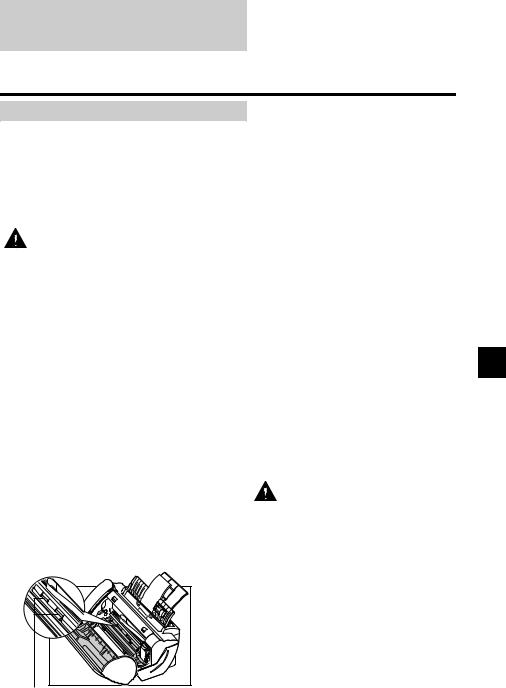
Periodic cleaning
Your fax requires little periodic maintenance. This section describes the necessary cleaning procedures for the fax. Please note the following before cleaning:
•Be sure to disconnect the power cord before cleaning the fax. Since documents in memory are erased when the power is disconnected, print any documents stored in memory before disconnecting the power cord (see p. 5-14).
•Do not use tissue paper, paper towels, or similar materials for cleaning; they can stick to the components or generate static charges.
Never use volatile liquids such as thinners, benzene, acetone, or any other chemical cleaner to clean
the interior of the fax.
Caution
Cleaning the exterior of the fax ________________
1 |
Disconnect the power cord from the fax. |
2 |
Wipe the exterior of the fax with a clean, |
|
soft, lint-free cloth moistened with water |
or diluted dishwashing detergent solution.
3When you are finished, reconnect the power cord.
Cleaning the interior of the fax ________________
K Cleaning inside the printer cover
To prevent ink spots and paper dust from accumulating inside the fax and affecting print quality, clean the print area of the fax periodically.
1 Disconnect the power cord from the fax. 2 Open the printer cover.
Do not touch the components or any metal parts.
Caution
3Use a clean, soft, dry, lint-free cloth to remove any ink or paper debris from the interior of the fax (shaded area), especially around the four pinch rollers.
Dirt and dust particles that collect on the underside of the printer cover affect the quality of the documents you copy or send.
Pinch rollers
Be careful not to touch the BJ cartridge or its holder.
9
PROBLEMS COMMON TO SOLUTIONS
9-3
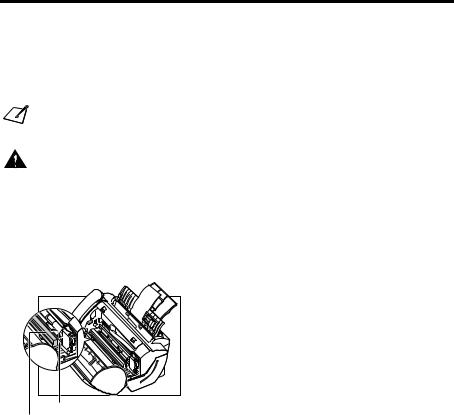
4 |
When you are finished, close the printer |
5 Reconnect the power cord. |
|
cover. |
|
Be sure to close the printer cover until it locks into place.
K Cleaning the scanner components
• If the scanner components are dirty, the documents you send or copy will also be dirty.
• Use a soft, lint-free cloth.
Note
Do not use tissue paper, paper towels, or similar materials for cleaning.
Caution
1Disconnect the power cord from the fax.
3While holding the white sheet open, clean the components:
Wipe with a clean, soft, lint-free cloth moistened with water, then wipe with a clean, soft, dry, lint-free cloth.
2Open the printer cover.
4Whencover. you are finished, close the printer
Be sure to close the printer cover until it locks into place.
White sheet
Scanning glass
5Reconnect the power cord.
9-4
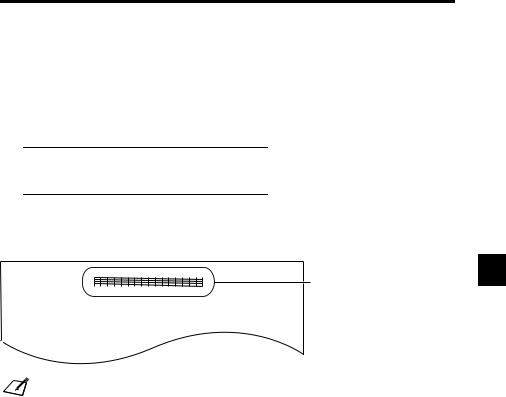
Periodic cleaning
Testing and cleaning the BJ cartridge print head __
The print head in the BJ cartridge contains nozzles through which ink is propelled onto the paper. To maintain the best possible print quality, these nozzles need to be cleaned from time to time. Your fax is equipped with a print head cleaning function that does this.
K Printing the nozzle check pattern
Before cleaning the print head, you may want to print the nozzle check pattern to test the print head of the BJ cartridge installed in the fax. This test shows if each print head nozzle is operating properly.
1Press [Function].
D
Press [Cleaning].
2Use [3] or [4] to select NOZZLE CHECK.
D
Press [Start/Copy].
The fax prints the nozzle check pattern.
Nozzle check pattern
If the pattern is broken or missing, clean the BJ cartridge print head (see p. 9-6).
Print the nozzle check pattern again after cleaning the BJ cartridge print head to check if cleaning corrected
the problem.
Note
9
PROBLEMS COMMON TO SOLUTIONS
9-5

K Cleaning the BJ cartridge print head
If your printouts become faint or streaked, or if their quality otherwise deteriorates, print the nozzle check pattern to see if the print head nozzles are operating properly (see p. 9-5). If the pattern is broken or missing, clean the BJ cartridge print head.
• To maintain the best possible print quality, clean the BJ cartridge print head from time to time.
• Cleaning the print head consumes a small amount of ink. Cleaning too often reduces the amount of ink
Note |
in the BJ cartridge. |
|
1
2
Press [Function].
D
Press [Cleaning].
Use [3] or [4] to select HEAD CLEANING.
D
Press [Start/Copy].
The fax cleans the print head.
• You can clean the print head up to five consecutive times if necessary.
• After cleaning, print the nozzle check pattern to check if cleaning corrected the problem
Note |
(see p. 9-5). |
|
|
|
• If cleaning does not improve print quality, replace the BJ cartridge (see below). |
Replacing the BJ cartridge ___________________
• Do not replace the BJ cartridge while the fax is printing or performing another operation.
• If you need to unplug the fax, wait until it returns to standby mode (time and receive mode displayed on
Note |
the LCD). Otherwise the cartridge holder may not be in its home position, causing the BJ cartridge to |
|
|
|
remain uncapped and dry out. |
1 Make sure the fax is plugged in. |
2 Open the printer cover. |
||
|
|
|
• Do not try to manually move or stop |
|
|
|
|
|
|
|
the cartridge holder. |
|
|
Caution |
• Do not touch the components shown or |
|
|
|
any metal parts. |
9-6
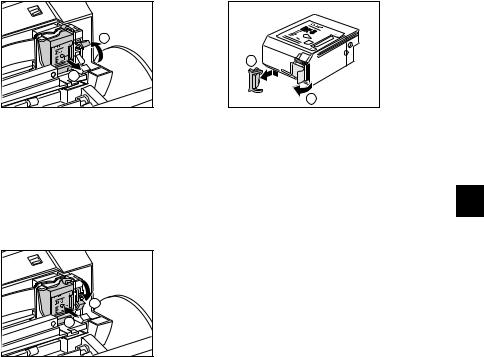
|
|
|
Periodic cleaning |
|
|
|
|
3 |
Raise the cartridge lock lever a on the |
4 |
Remove the new BJ cartridge from its |
cartridge holder and remove the BJ |
package, then remove the orange |
||
|
cartridge b. |
|
protective cap a and tape b. |
1 |
2 |
•Discard the old BJ cartridge immediately according to the local laws and regulations for disposal of consumables. You may want to place it in a plastic bag to keep any residual ink from spilling.
•Spilled ink can stain any surface; protect yourself and your work area.
1
2
•Discard the cap and tape. Never attempt to reattach them to the BJ cartridge print head.
•Install the BJ cartridge immediately after removing the cap and tape.
•Spilled ink can stain any surface; protect yourself and your work area.
5With the label facing outwards, insert the BJ cartridge into the cartridge holder a. Lower the cartridge lock lever b until you hear a click to lock the cartridge in place.
2 |
1 |
6Close the printer cover.
If the AUTO TEST PRINT setting is set to ON:
The fax automatically prints a test page. The fax prints a test page every time you insert a BJ cartridge.
•Load the paper in the multi-purpose tray before you replace the BJ cartridge.
•You can turn off automatic test printing by changing the AUTO TEST PRINT setting. See SYSTEM SETTINGS, p. 8-5.
The white post (BJ cartridge guide) should be visible through the slot.
The BJ cartridge tilts slightly to the left in the loaded position.
9
PROBLEMS COMMON TO SOLUTIONS
9-7

Troubleshooting
Paper feeding problems _____________________
o Paper does not load.
The multi-purpose tray may contain too many sheets.
•Make sure the paper stack in the multi-purpose tray does not exceed the paper limit mark (P) (see p. 1-7).
Paper may not be loaded correctly.
•Make sure the paper stack is loaded properly in the multi-purpose tray, and that the paper guide is adjusted correctly (see p. 1-8).
o Paper is loaded skewed. (Printing is skewed.)
Paper may not be loaded correctly.
•Make sure the paper stack is loaded properly in the multi-purpose tray, and that the paper guide is adjusted correctly (see p. 1-8).
•Make sure the right edge of the paper stack is aligned with the right side of the multi-purpose tray and the paper guide is aligned with the left edge of the stack (see p. 1-8).
•Make sure the paper exit path is clear.
o Multiple sheets load into the fax at the same time.
Paper may not be loaded correctly.
•Make sure the paper stack is loaded properly in the multi-purpose tray, and that the paper guide is adjusted correctly (see p. 1-8).
Sheets of paper may be sticking together.
•Be sure to fan the paper stack before loading it in the multi-purpose tray. This keeps the sheets of paper from sticking together (see p. 1-8).
The multi-purpose tray may contain too many sheets.
•Make sure the paper stack in the multi-purpose tray does not exceed the paper limit mark (P) (see p. 1-7).
•Do not exceed the maximum loading capacity of the multi-purpose tray (see p. 1-7).
•Do not force the paper stack into the multi-purpose tray.
Different types of paper may be loaded in the multi-purpose tray.
•Load only one type of paper.
•Make sure you load paper that meets the paper requirements for the fax (see Chapter 3).
o Repeated paper jams occur.
The paper you are using may be causing the jams.
•Be sure to fan the paper stack before loading it in the multi-purpose tray. This keeps the sheets of paper from sticking together (see p. 1-8).
•Check that the paper you are using and your printing environment (see pp. 1-7, S-1) are within the specifications of the fax (see Chapter 3).
9-8
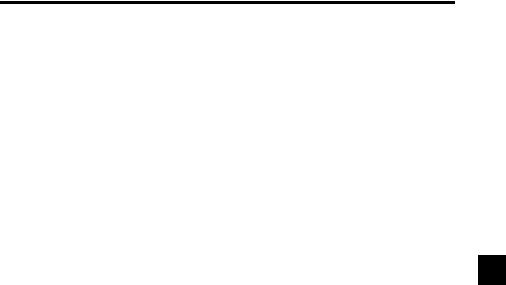
Troubleshooting
Faxing problems ___________________________
Sending problems
o You cannot send a document.
The BJ cartridge may not be installed properly.
•Make sure the BJ cartridge is installed properly. Do not remove a used BJ cartridge except to replace it with a new one.
The fax may have overheated.
• Unplug the fax and let it cool for several minutes. Then plug it back in and try sending again.
The fax may not be set for the type of telephone line in use (pulse/tone).
• Make sure the fax is set for the correct telephone line type (see p. 1-12).
The document may not have been loaded correctly into the document tray.
•Remove the document, stack it if necessary, and load it into the document tray correctly (see p. 3-2).
•Make sure the printer cover is closed.
The one-touch speed dialling button or coded speed dialling code you entered may not be registered for the feature you want to use.
•Check the one-touch speed dialling button or coded speed dialling code and make sure it is registered correctly (see Chapter 2).
You dialled or have been provided with an incorrect number.
• Dial the number again, or check that you have the correct number.
The receiving party’s fax machine may be out of paper.
• Call the receiving party and ask them to make sure paper is loaded in their fax machine.
There may be other documents being sent from memory.
• Allow time for those documents to finish sending.
An error may have occurred during sending.
• Print an activity report and check for an error (see p. 8-7).
The telephone line may not be working properly.
•Make sure there is a dial tone when you press [Hook] or when you lift the handset. If there is no dial tone, contact your local telephone company.
The receiving fax machine may not be a G3 fax machine.
• Make sure the receiving fax machine is compatible with the fax (which is a G3 fax machine).
o Documents sent from the fax are spotted or dirty.
The receiving fax machine may not be working properly.
•Check the fax by making a copy (see p. 4-1). If the copy is clear, the problem may be in the receiving fax machine. If the copy is spotted or dirty, clean the scanner components (see p. 9-4).
The document may not have been loaded correctly into the document tray.
• Remove the document, stack it if necessary, and load it into the document tray correctly (see p. 3-2).
9
PROBLEMS COMMON TO SOLUTIONS
9-9

o Cannot send using Error Correction Mode (ECM).
The receiving party’s fax machine may not support ECM.
•If the receiving party’s fax machine does not support ECM, then the document is sent in normal mode without error checking.
ECM may be disabled.
• Make sure ECM is on (see ECM TX, p. 8-3).
o o Errors occur frequently while sending.
The telephone lines may be in poor condition, or you may have a bad connection.
• Lower the transmission speed (see TX START SPEED, p. 8-5).
Receiving problems
o Cannot receive a document automatically.
The fax may not be set to receive automatically.
•For the fax to receive faxes automatically, the receive mode must be set to FAX ONLY MODE, FAX/ TEL AUTO SW (Fax/Tel mode), or ANS.MACHINE MODE* (see Chapter 6). If you have set ANS.MACHINE MODE*, check that an answering machine is connected to the fax and that it is turned on with an outgoing message properly recorded (see p. 7-1).
The fax may have a document stored in memory.
• Print out any documents stored in memory (see p. 5-14).
An error may have occurred during reception.
•Check the LCD for an error message (see p. 9-15).
•Print an activity report and check for an error (see p. 8-7).
The multi-purpose tray may be empty.
• Make sure paper is loaded in the multi-purpose tray (see p. 1-8).
The telephone line may not be connected properly.
• Make sure all line connections are secure (see p. 1-4).
* FAX-B120/B115 only.
9-10
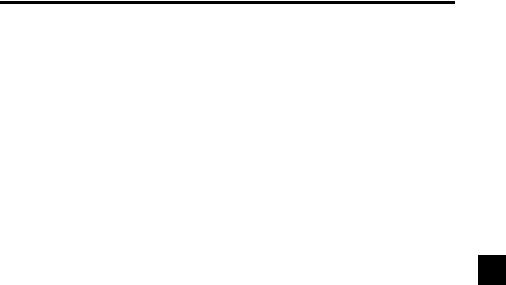
Troubleshooting
oThe fax does not switch automatically between telephone and fax reception.
The fax may not be set to switch automatically between telephone and fax reception.
•For the fax to switch automatically, the receive mode must be set to FAX/TEL AUTO SW (Fax/Tel mode) or ANS.MACHINE MODE* (see Chapter 6). If you have set ANS.MACHINE MODE*, check that an answering machine is connected to the fax and that it is turned on with an outgoing message properly recorded (see p. 7-1).
An error may have occurred during reception.
•Check the LCD for an error message (see p. 9-15).
•Print an activity report and check for an error (see p. 8-7).
The multi-purpose tray may be empty.
• Make sure paper is loaded in the multi-purpose tray (see p. 1-8).
The sending fax machine may not send the CNG signal that tells the fax that the incoming signal is a fax.
•Some fax machines cannot send the CNG signal that tells your fax the incoming call is from a fax machine. In such cases, you will have to receive the document manually (see p. 6-4).
o Cannot receive a document manually.
You may have disconnected the call by pressing [Start/Copy] or dialling the remote receiving ID after hanging up the handset of the extension phone.
•Always press [Start/Copy] or dial the remote receiving ID before hanging up the handset, otherwise you will disconnect the call.
o Print quality is poor.
You may not be using the correct type of paper.
• Make sure you load paper that meets the paper requirements for the fax (see Chapter 3).
The BJ cartridge print head may need cleaning.
• Clean the BJ cartridge print head if necessary (see p. 9-6).
The sending fax machine may not be functioning properly.
•The sending fax machine usually determines the quality of the document. Call the sender and have them make sure the top cover and scanning glass of their fax machine are clean.
Error Correction Mode (ECM) may be disabled.
• Make sure ECM is on (see ECM RX, p. 8-4).
* FAX-B120/B115 only.
9
PROBLEMS COMMON TO SOLUTIONS
9-11

o Fax does not print.
The BJ cartridge may not be installed properly.
•Make sure the BJ cartridge is installed properly (see p. 1-9).
•Be sure to remove the orange protective tape from the BJ cartridge before you install it (see p. 1-10).
The BJ cartridge print head may need cleaning.
• Clean the BJ cartridge print head if necessary (see p. 9-6).
The BJ cartridge may need to be replaced.
• Determine if the problem is with the BJ cartridge and replace it if necessary (see p. 9-6).
o Fax images print blotched or uneven.
The telephone lines may be in poor condition, or you may have a bad connection.
•Error Correction Mode (ECM) sending/receiving should eliminate such problems. However, if the telephone lines are in poor condition, you may have to try again.
The sending fax machine may not be functioning properly.
•The sending fax machine usually determines the quality of the document. Call the sender and have them make sure the top cover and scanning glass of their fax machine are clean.
o Cannot receive using Error Correction Mode (ECM).
The sending fax machine may not support ECM.
•If the sending fax machine does not support ECM, then the document is received in normal mode without error checking.
ECM may be disabled.
• Make sure ECM is on (see ECM RX, p. 8-4).
o Errors occur frequently while receiving.
The telephone lines may be in poor condition, or you may have a bad connection.
• Lower the reception speed (see RX START SPEED, p. 8-5).
The sending fax machine may not be functioning properly.
• Call the sender and have them check that their fax machine is functioning properly.
9-12

Troubleshooting
Copying problems __________________________
o The fax does not make a copy.
The BJ cartridge may need to be replaced.
• Determine if the problem is with the BJ cartridge and replace if necessary (see p. 9-6).
The document may not have been loaded correctly into the document tray.
•Remove the document, stack it if necessary, and load it into the document tray correctly (see p. 3-2).
•Make sure the printer cover is closed.
The BJ cartridge may not be installed properly.
• Make sure the BJ cartridge is installed properly (see p. 1-9).
The fax may not be operating properly.
• Print the nozzle check pattern (see p. 9-5).
o MEMORY FULL appears on the LCD when making multiple copies.
The fax’s memory is full.
•Print or delete any documents stored in memory (see pp. 5-14, 5-15) to free up space in the fax’s memory, then start again.
•If you have any page fed out without being copied, simply try copying those pages again.
• Change the scanning resolution and try copying again.
The document you are copying may have too many graphics.
•If multiple pages are being copied, separate the pages into smaller stacks. If not, make the desired number of copies one at a time as needed.
For additional troubleshooting, see Print quality problems, p. 9-14.
Note
Telephone problems ________________________
o You cannot dial.
The telephone line may not be connected properly.
• Make sure all line connections are secure (see p. 1-4).
The power cord may not be plugged in securely.
•Check that the power cord is plugged securely into the fax and into the wall outlet (see p. 1-6). If the fax is plugged into a power strip, make sure the power strip is plugged in and turned on.
The fax may not be set for the type of telephone line in use (pulse/tone).
• Make sure the fax is set for the correct telephone line type (see p. 1-12).
oThe handset, telephone, or extension phone disconnects while you are talking.
The power cord may not be plugged in securely.
•Check that the power cord is plugged securely into the fax and into the wall outlet (see p. 1-6). If the fax is plugged into a power strip, make sure the power strip is plugged in and turned on.
o There is interference on the line.
A mobile phone or cordless phone may be in use near the fax.
• Make sure that mobile phones and cordless phones are not used near the fax.
9
PROBLEMS COMMON TO SOLUTIONS
9-13
